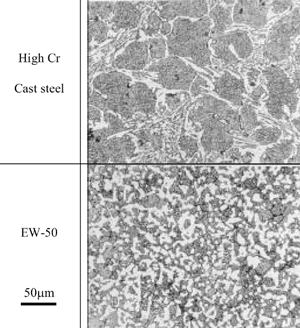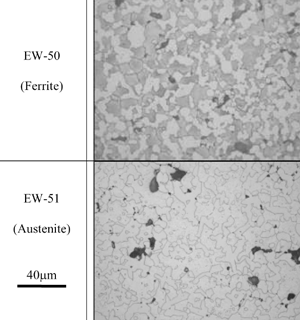High chromium sintered stainless steels for auto turbocharger parts
The use of variable nozzle turbochargers (VNTs) has grown rapidly in recent years as automobile manufacturers respond to the challenges of reducing CO2 emissions and other environmentally harmful exhaust gases as well as the need to continually improve fuel efficiency of engines.
VNTs are said to improve engine performance by boosting pressure which can be controlled by adjusting the opening (nozzle) of the variable vane in relation to the engine speed. The authors Fukae and Kamaka from Hitachi Powdered Metals Ltd reported in their presentation at the 2012 SAE International Congress that this type of turbocharger is effective in reducing NOx, and helps to meet exhaust gas regulations (EGR).
However, the continuing improvements in automotive engine performance has also led to a requirement for VNTs to operate at higher temperatures, placing increasing demands on components such as the nozzle ring which is exposed directly to hot exhaust gases. Such components need to be produced from materials which posses both high oxidation resistance and wear resistance at the high temperatures of the exhaust gases.
Hitachi Powdered Metals states that high chromium cast steel is generally used for nozzle rings, but the trend to high performance turbocharged diesel engines and the increased future use of turbochargers also in petrol engines has required turbocharger components to cope with exhaust gas temperatures up to 1323K (1050C). The company has, therefore, evaluated a recently developed PM version of the high Cr stainless steel which it states can provide improved heat, wear and corrosion resistance at the above temperature compared with the cast steel. At the same time the authors state that the PM process can offer cost reductions through its near-net shaping capability.

Table 1 Chemical composition of PM EW-50 and high Cr cast steel. (From paper by D. Fukae and H. Kawata: ‘Development of High Cr Sintered Stainless Steel with High Heat and Wear Resistance’, presented at the SAE International Congress, Detroil, April 24-26, 2012. 2012-01-0062)
The matrix PM high Cr stainless steel is produced from a water atomized alloy powder comprising Fe-34Cr-2Mo-1.6Si-1C. This is close to the composition of the cast steel. This matrix alloy powder is mixed with 2.5% P-Fe, 1.5% graphite and 0.5% pressing lubricant. The mixture is compacted at 600 MPa and the green compacts were liquid phase sintered to high density at 1483K (1210C). Hitachi Powdered Metals has designated this high Cr stainless steel PM material EW-50. Table 1 compares the compositions of the PM and cast materials. The sintered EW-50 material has a microstructure with twice the dispersion of carbides in the ferritic matrix as in the cast material as can be seen in Fig.1.

Fig.1 Comparison of microstructures of high Cr cast
steel and EW-50. (From paper by D. Fukae and
H. Kawata: ‘Development of High Cr Sintered
Stainless Steel with High Heat and Wear Resistance’,
presented at the SAE International Congress,
Detroil, April 24-26, 2012. 2012-01-0062)
The authors carried out tests on wear and oxidation resistance and also determined the mechanical properties of the EW-50 PM material. They found that wear of the PM high Cr stainless steel is less than half that of the high Cr cast material. This was aided by the sliding surface of the EW-50 PM material whereas that of the cast steel had been roughened by severe adhesion. The improved wear resistance was attributed to the large quantity of finely distributed Cr carbides in the ferritic EW-50 matrix.

Fig.2 Microstructures of ferritic EW-50 and austenitic
EW-51. (From paper by D. Fukae and H. Kawata:
‘Development of High Cr Sintered Stainless Steel
with High Heat and Wear Resistance’, presented at
the SAE International Congress, Detroil,
April 24-26, 2012. 2012-01-0062)
In terms of oxidation resistance, the authors found that the growth of oxides tends to occur around the carbides and that in the cast material oxidation easily progresses inward. This is because the carbides form in a linked network shape. In the PM EW-50 material the Cr-depleted layer is discontinuous due to the fine particle shape which makes it more difficult for oxidation to progress into the interior of the material. As a result the EW-50 material shows superior oxidation resistance. The authors also reported that EW-50 shows values equal to or better than the cast material for high temperature tensile strength and hardness.
Austenitic EW-51
Where turbocharger materials are required to have the combination of high temperature strength and the same thermal expansion coefficient to austenitic stainless steels for combination with other parts, Hitachi Powdered Metals has developed an austenitized version of EW-50 called EW-51.
To achieve this 11% Ni was added as the austenitic stabilising element and C was increased to 3.7%. Despite the higher carbon content of EW-51 the material has similar corrosion resistance to the EW-50 material because the matrix has the same Cr content and the quantity and morphology of the carbides are at the same level as EW-50.
It was confirmed by the authors that both EW-51 and EW-50 have extremely high wear resistance and oxidation resistance, under high temperature environments exceeding 973K, with the austenitic EW-51 additionally offering high thermal expansion coefficient. The authors expect both materials to find applications in turbochargers with the EW-51 material expected to find applications in turbochargers for gasoline engines.
News | Articles | Market reviews | Search directory | Subscribe to e-newsletter





